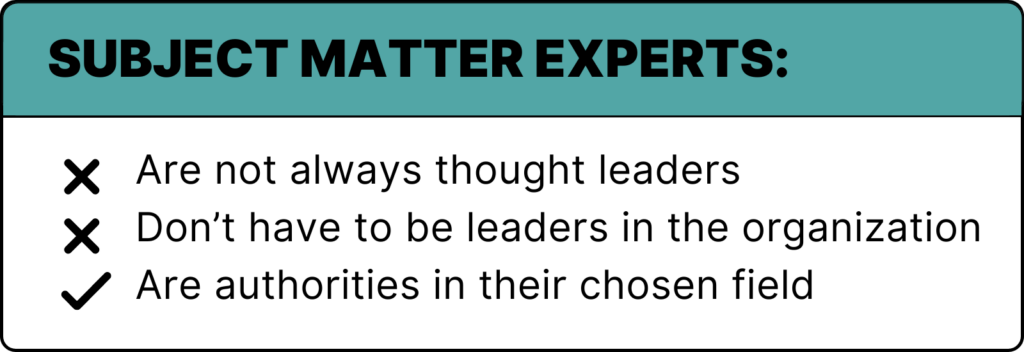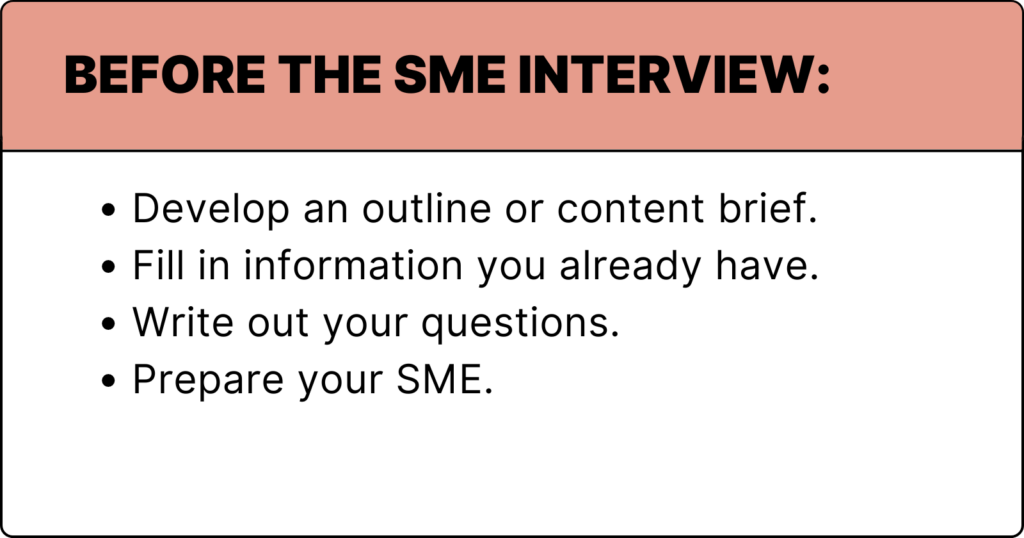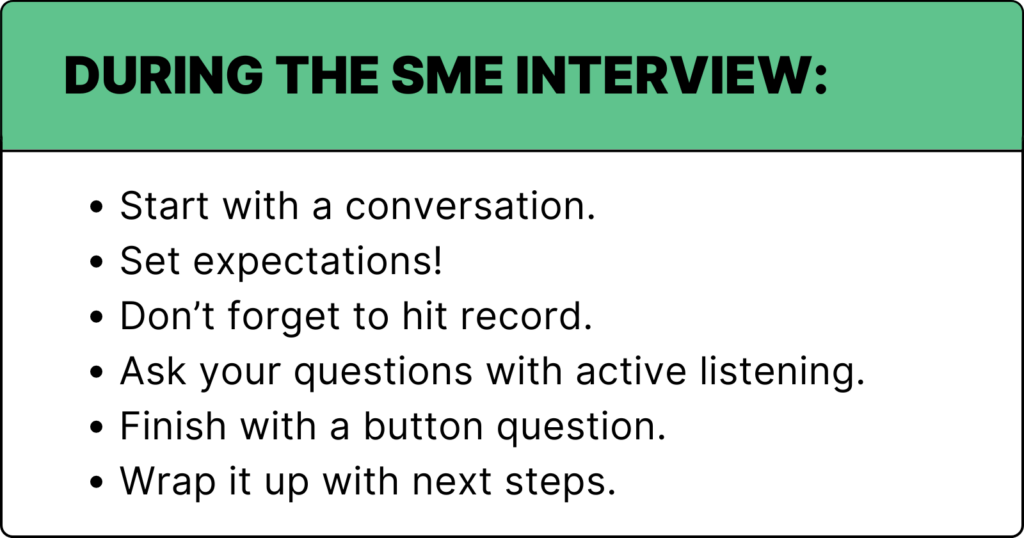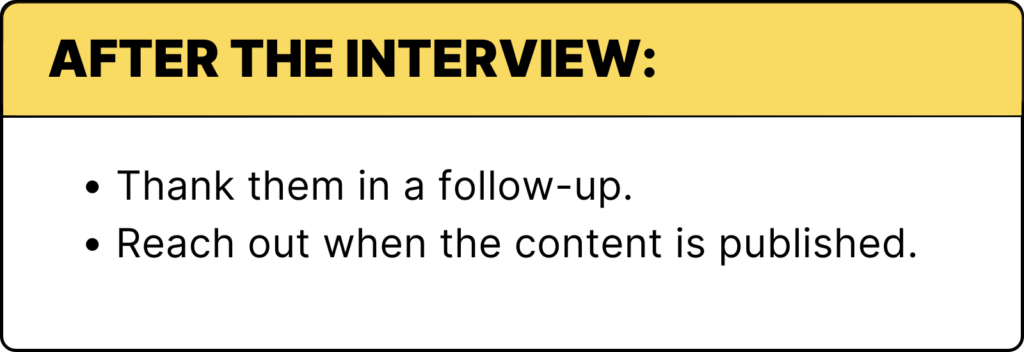No matter where you are in your content marketing career, you will need to interview subject matter experts (SMEs) if you haven’t already done so.
It’s an integral part of the job because, let’s face it, we can’t know everything.
I’ve worked in content marketing for almost ten years. In that time, I’ve probably interviewed hundreds of subject matter experts and thought leaders, and I’ve made plenty of mistakes.
Just recently, I forgot my own golden rules and jumped right into the interview. I didn’t set expectations, I didn’t put the interviewee at ease, and I barely introduced myself. I missed a critical opportunity to create a rapport with my SME, which could have jeopardized the content.
Okay, maybe them’s strong words, but it’s true. Without that rapport, the SME is less likely to open up to me and may feel uncomfortable answering my questions. Luckily, as I was jumping into my questions, this SME stopped me and said, “I don’t even know what this is about.”
It gave me the chance to course correct and made my article more substantial than it would have been had we both bulldozed into the interview.
To avoid similar mistakes, I’ve created a list of steps to help you create a great interview experience for your subject matter expert while getting all the information you need for your content piece. We’ll quickly cover the definition of a subject matter expert before diving into what to do before, during, and after your interview.

Who Are Subject Matter Experts?
First, let’s get one thing straight: A subject matter expert is not necessarily a thought leader, though thought leaders can be subject matter experts. SMEs, however, can become thought leaders as they develop and share strong opinions related to their expertise.
Simply put, a subject matter expert is an authority in their chosen field, a specific area of that field, or a process, method, or type of equipment.
They don’t always have to be a CEO or leader in their department; they just need the expertise to provide the information you need for your content. Their leaders do, however, need to trust them to provide you with accurate information that reflects the company’s viewpoint. Case in point: one of my contacts directed me toward an SME for a white paper I was writing. The SME, however, was new to the company and didn’t want to contradict the company’s typical advice accidentally, so he asked his department head to join the interview.
Now that you know who you’re interviewing, let’s jump in.

Pre-Interview Prep
Before you jump into the interview with your SME, there are some obvious things you need to do to prepare. Not only will your unpreparedness make you look woefully behind, but it will likely make your SME uncomfortable. When you re-review your recording later, you’ll probably cringe.
Oof, been there.
Here are a few things you can do before your interview to get ready:
Develop an Outline or Content Brief
If you don’t already have an outline or content brief from your content team, or you are the sole content team member, then you need to create one. This should include:
- Basic information about the content topic, such as a title or general description.
- The target audience for the content.
- What you want them to do after interacting with the content.
- The major topics you need to touch on.
- Keywords, if this is an SEO-based post.
Fill in Information You Already Have
If your company or client has already written on this topic, seek out previous content and fill in the corresponding sections of the outline — and I don’t just mean previous blog posts. Did your SME discuss this topic on a podcast or in webinars? Did they touch on it in a LinkedIn post (as long as you can find it)? Does your company have any sales one pagers that cover the information?
Do what you can to make creating the content as easy as possible for you and your SMEs so the interview covers only new information.
Write Your Questions
Now that you know where your holes are, you need to write your questions down. This doesn’t mean that you’ll have to stick to the wording rigidly, or you won’t ask additional questions later — these are to help guide you and your SME during the interview.
Make sure your questions are open-ended and can’t be answered with a simple “Yes” or “No.” If you must ask close-ended questions, I recommend adding a quick follow-up like, “Why or why not?”
Prepare Your SME
This is probably a big “Duh” moment, but once all this is done, you need to schedule the interview. But your outreach shouldn’t just be a list of dates and times to meet. You need to equip your SME with the correct information so they know what the conversation will be like.
If they don’t know who you are, introduce yourself, explain your role, and why you’re contacting them. Set expectations by letting them know what the project is and what you need from them. Lastly, send them the questions ahead of time so they can prepare.

During Your SME Interview
It’s today! You’ve made sure your camera is working. You’ve tested your mic. You’ve begged your family (fur or otherwise) to let you take this meeting in peace. You’ve gone to the bathroom. And now, you’re anxiously waiting for your interviewee to show up.
While you wait, take a deep breath in and exhale. You’ve got this.
Once they do, what next?
Start With a Conversation
I have ADHD, and my wife is Autistic. It is very easy for me to forget about easing into a conversation. Asking people how they are. Talking about the weather. When I zoom in on completing a task, such as an interview, I can forget everything else.
That’s a mistake. Starting an interview as a conversation helps your SME get to know who you are and helps the rest of the interview flow organically rather than be prescriptive.
Set Expectations
I cannot say this enough times. I mentioned setting expectations in the pre-interview, but they might have forgotten or missed that information in the email. Regardless, it doesn’t hurt to reiterate the content topic, who the target audience is, why you need their expertise, and what they can expect to happen after the interview.
Don’t Forget to Hit Record
I once worked on a webinar where a colleague forgot to hit that big red button until halfway through. We lightly panicked before laughing it off because we could rerecord the first half. You might not get that chance. Make sure you hit record before you start recording, and if you can, use additional tools like AI note-takers to help organize the notes you get.
Ask Your Questions
It’s time to start asking your questions, but there are a few things that you should keep in mind to make the process go smoothly:
- Keep the conversation going. This is why you started with small talk. This should be comfortable for your SME. Laugh when they make a joke, and don’t be afraid to make jokes yourself if it’s appropriate. It’s all about building a rapport.
- Actively listen. Paraphrase their answers, respond, and follow up with additional questions if you need them to expand on a response.
- Don’t be afraid of silence. People get uncomfortable during silence and tend to fill it, so if an answer seems too easy, pause before asking a follow-up.
- Gently get back on track. On the other hand, your SME might focus too long on an answer. Find a spot in their answer to gently segue into your next question.
Finish With a Button Question
As you finish with your list of questions, I recommend one final button to wrap it up. I like to ask, “What is the No.1 thing you want someone to know after interacting with this content?” while others like to ask, “Is there anything I haven’t asked that I should?”
Wrap It Up With Next Steps
Finalize the interview with the next steps. If they are involved in the review process, explain when they should expect a first draft and what they should look out for during their review. If you have a set publishing date, let them know, and make sure you get their social handles so your team can tag them correctly!

Post-Interview
Now that the interview is done, you only have a few more steps to take — other than putting the content together, of course!
Your final two steps are as follows.
Thank Them in a Follow-up Email
Send your SME a follow-up email thanking them for their time. In this email, reiterate the next steps you shared during the interview so they don’t forget.
Reach Out When the Content Is Published
When your content is ready to be published, let them know so they can prepare to promote the piece to their followers. If your team creates social designs for them, share that with them as well. And confirm their social handles so you don’t tag the wrong John Smith, for example.
Interviewing a Subject Matter Expert? Remember Your Nerves, Too
While much of this piece has been about how to conduct a subject matter expert interview and how to quiet their nerves and set them at ease, don’t forget about yourself, too.
By being ready for your interview with your questions, knowing the content’s goals, and setting expectations, you’re halfway there. Just don’t forget to breathe.
I’m going to add one final tip here: Be human. You’ll stumble over your words sometimes, and you might feel awkward at first, but it will get easier the more you interview SMEs.
Looking for more insights like these? Sign up for our LinkedIn newsletter.






